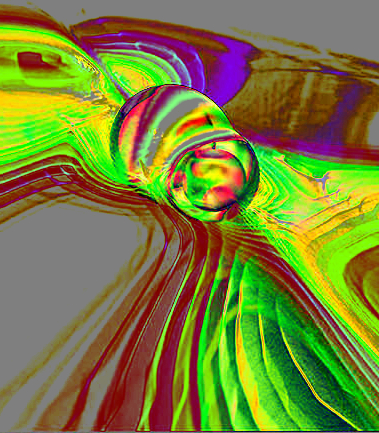Cosmic collision captured
 Researchers have observed an entirely new phenomenon in the Universe; the death spiral and merger of a neutron star and a black hole.
Researchers have observed an entirely new phenomenon in the Universe; the death spiral and merger of a neutron star and a black hole.
Experts have revealed that the first ever human observation of a neutron star-black hole merger was made on 5th January 2020 when gravitational waves - tiny ripples in the fabric of space and time - were detected from the collision event.
When masses collide in space, they shake the very fabric of the Universe itself, sending out gravitational waves, like ripples on the surface of a pond.
Detailed analysis of these waves has shown that the neutron star was around twice as massive as the Sun, while the black hole was around nine times as massive as the Sun.
The merger itself happened around a billion years ago, but the gravitational waves only just reached Earth.
Just over a week after this first observation, another merger of a neutron star and a black hole was detected in gravitational waves.
This neutron star and black hole also collided around a billion years ago, but it was slightly less massive: the neutron star was around one and a half times as massive as the Sun, while the black hole was around five and a half times as massive.
“It’s an awesome milestone for the nascent field of gravitational-wave astronomy,” says Dr Rory Smith, an astrophysicist at the ARC Centre of Excellence for Gravitational Wave Discovery (OzGrav) at Monash University, who co-led the international team of scientists in this discovery.
“Neutron stars merging with black holes are amongst the most extreme phenomena in the Universe. Observing these collisions opens up new avenues to learn about fundamental physics, as well as how stars are born, live and die.”
The observations were officially announced by the Laser Interferometer Gravitational-Wave Observatory (LIGO), in the US, and the Virgo gravitational-wave observatory in Italy.
Thousands of international scientists teamed up for the world-first detection, with Australia playing a leading role.
“From the design and operation of the detector, to the analysis of data, Australian scientists are working at the frontiers of astronomy,” Dr Smith says.
The SPIIR pipeline, at the University of Western Australia (UWA) - Australia's only real-time gravitational-wave search pipeline - detected a neutron star-black hole event in real-time for the first time.
SPIIR is one of five pipelines that alerts astronomers around the world within seconds of gravitational events, so they can try to catch the potential flash of light emitted when a neutron star is torn apart by its companion black hole.
“Observing a neutron star-black hole merger fills in another missing piece in our collection,” says OzGrav Postdoctoral Researcher Dr Daniel Brown, from the University of Adelaide.
“OzGrav expertise and technology played a crucial role in enhancing the performance of the LIGO detectors to enable these fascinating new measurements.
“Researchers and students spent over 1,000 days at the LIGO sites during the last observation run installing new hardware and tuning up the performance.
“A key contribution was the installation of new hardware to generate what is known as ‘squeezed light’, which is a special quantum state of light that reduces the noise in our measurements.
“The Heisenberg uncertainty principle suggests there is a limit to how sensitive we can make the detectors, but by using squeezed light we can get around it.”







 Print
Print